Acer Aspire TimelineU M3: Life on the Kepler Verge
by Dustin Sklavos on March 13, 2012 5:56 PM ESTApplication and Futuremark Performance
While we've said before that Intel Core i7-2637M performance is pretty much a known quantity, Acer's TimelineU M3 takes things in a different direction. This is a 15.6" notebook that has dimensions comparable with Dell's XPS 14x and 15z, and a GPU that's at least theoretically well beyond either. At this juncture it's now worth seeing if the i7-2637M is a huge hit compared to, say, a standard voltage i5.
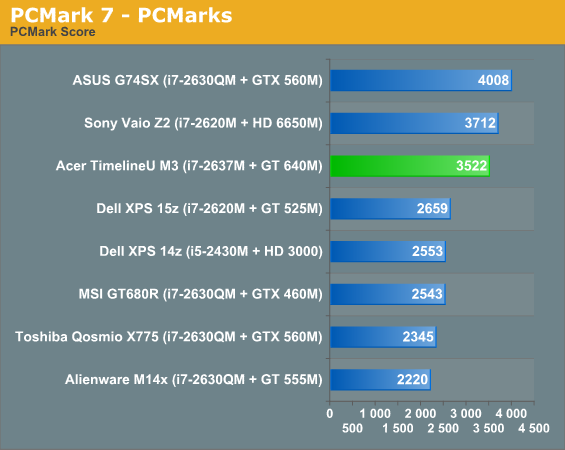
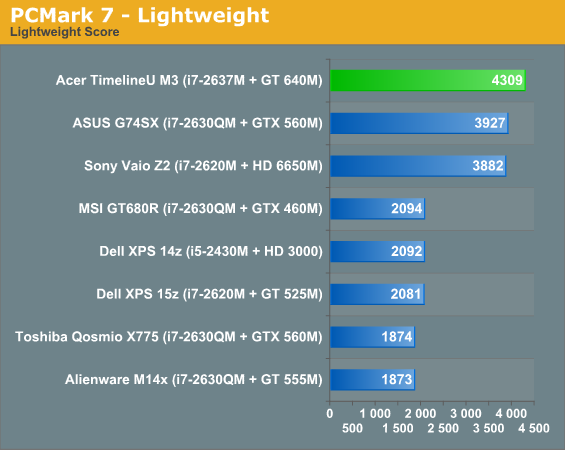
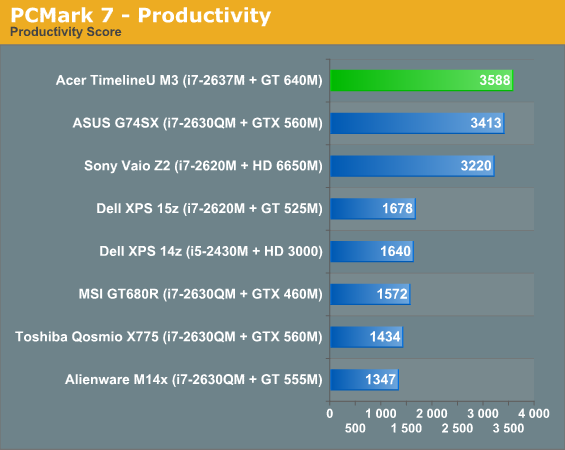
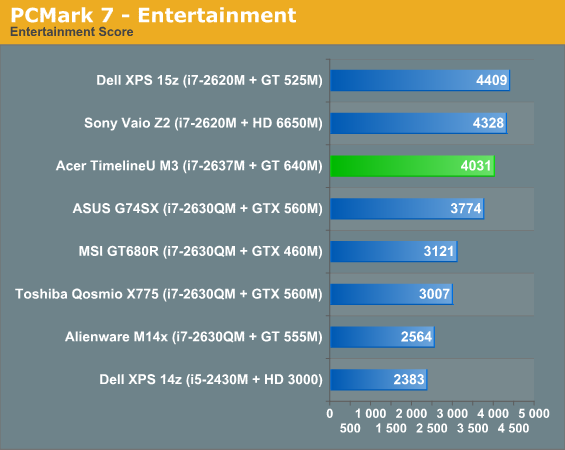
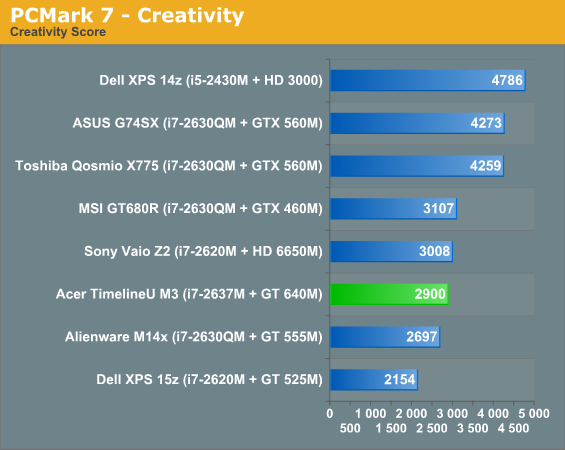
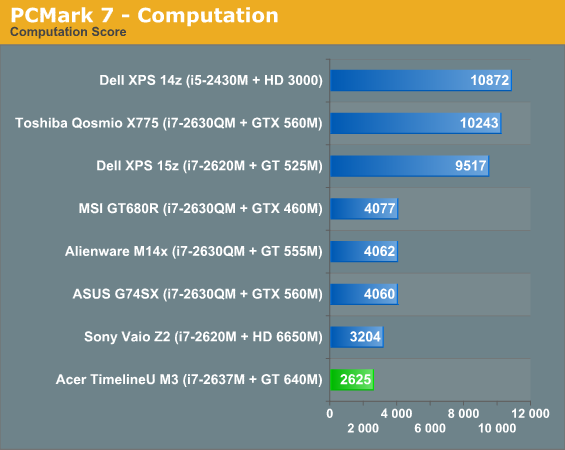
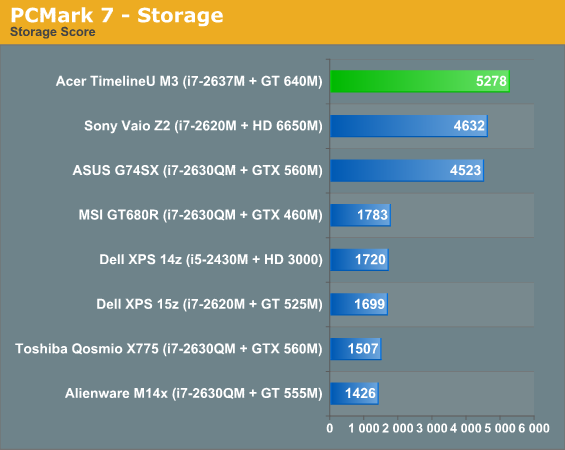
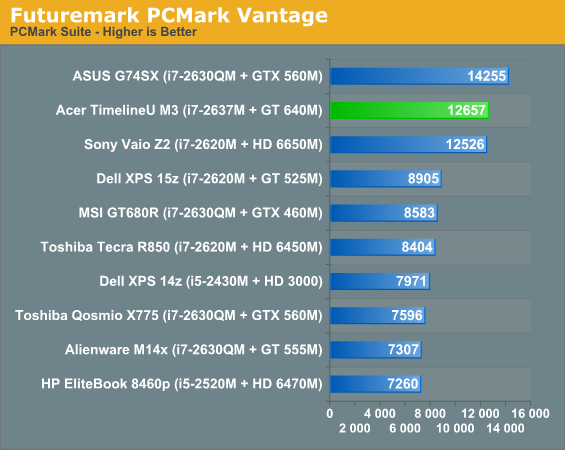
PCMark skews happily and heavily towards the reasonably fast SSD in the M3, despite that SSD only running at SATA 3Gbps speeds. The Computation benchmark also skews towards Intel's QuickSync, and it appears some of NVIDIA's drivers used to defer to the IGP during PCMark7. Let's see what happens when we shift the focus entirely to the CPU proper.
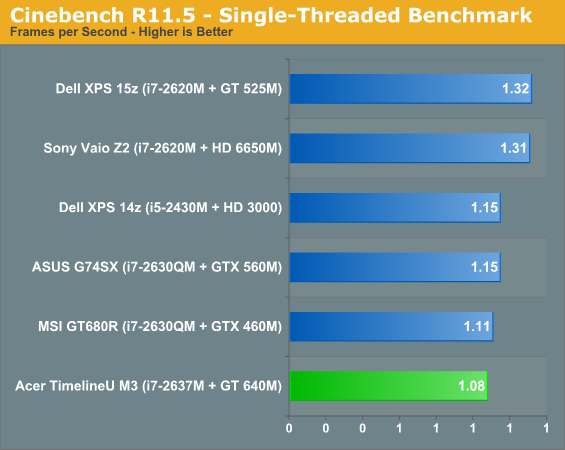
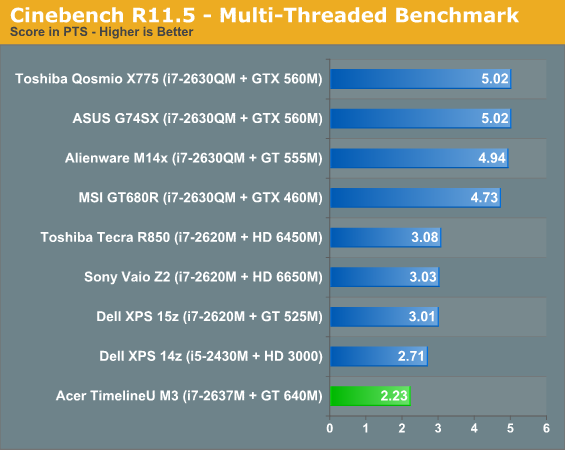
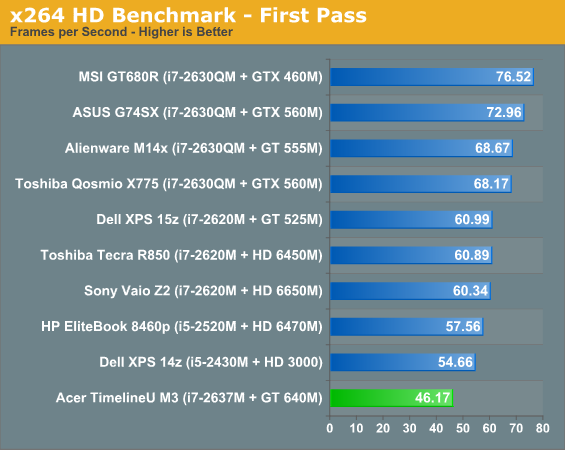
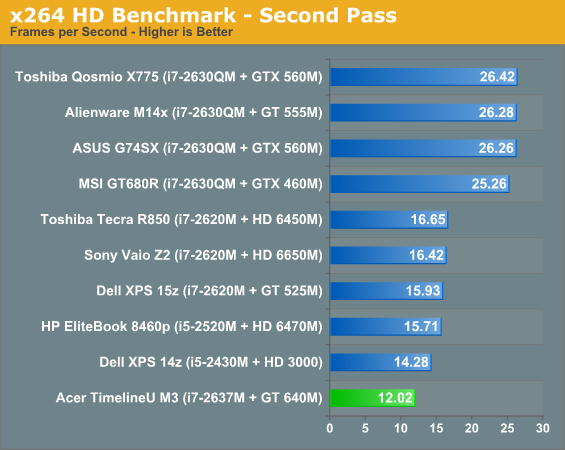
Unfortunately things just aren't so rosy once standard voltage CPUs are added to the equation. The i7-2637M doesn't perform poorly, but run-of-the-mill i5s do produce a good lead on it, and anything with four cores demolishes it as expected.

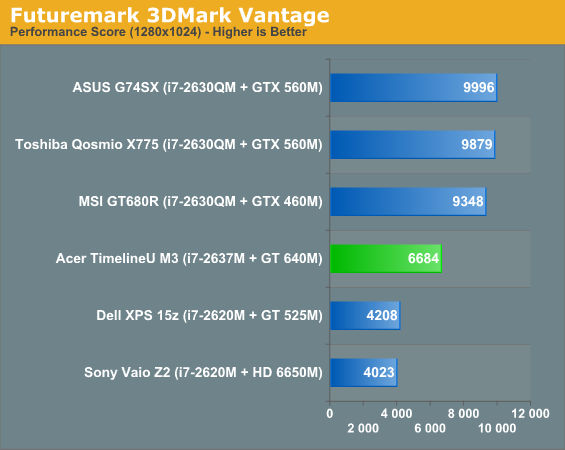
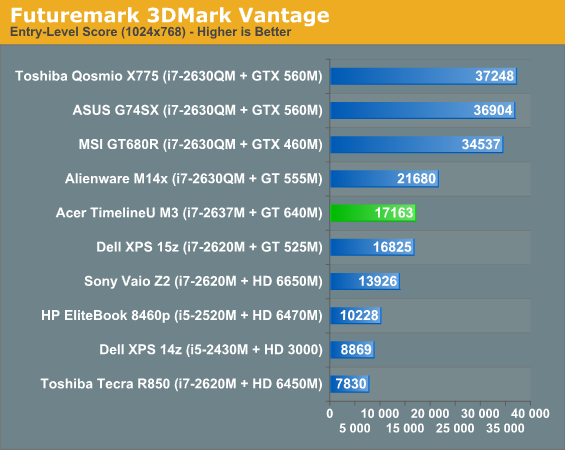
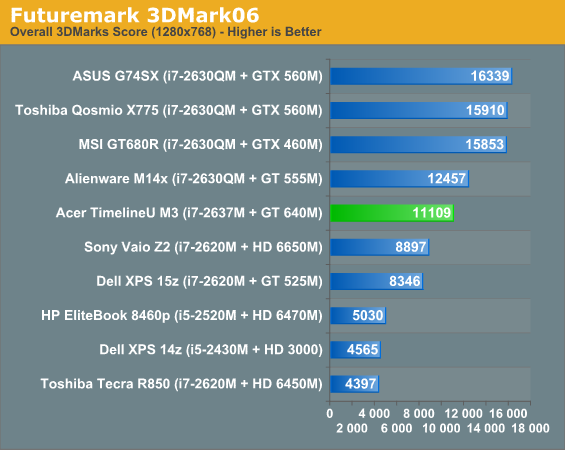
On the other hand, 3DMark approves of the GeForce GT 640M's substantial shader power. We don't have any systems with the GT 540M on our chart, but given how the 640M is nipping at the M14x's GT 555M's heels, it's reasonable to assume the 640M is able to largely demolish its predecessor. What's interesting is seeing how the 640M's 384 CUDA cores compare to the GTX 460M/560M in practice, both of which have just 192.










76 Comments
View All Comments
lcarsos - Wednesday, March 14, 2012 - link
Oh my the screen is 768p? I would certainly hope that the screen is refreshed in a progressive manner! If my cursor were to start interlacing as I moved it around I would probably start a bar fight.My point is, why would an unnecessary descriptor such as "progressive" get slipped into a laptop review? Man up, and display the screen pixelage, of course the laptop is going to display things progressive it wasn't a television designed in the 60s. Now if you were to stick a DVD in there, DVDs are encoded interlaced in most cases. Now what's happening? A progressive display of interlaced images? Better to just leave that out of the review.
Also, 1366x768 in a 15.6" laptop? What committee let that through? In an age where the iPad can end up with 2048x1536 pixels in a 10" screen for $500 they can certainly slip in a higher quality screen at the price they are currently at. Even if it is still a TN panel. I have a 14" Thinkpad with a 1600x900 display, at no point should a screen of larger size come with lower resolution.
Glock24 - Wednesday, March 14, 2012 - link
I've been looking for a laptop to replace my aging Asus F8Va (which has a 14" 1440x900 screen), but every single manufacturer insists on using crappy 1366x768 screens. And I say crappy screens not just because of the resolution, but also because of the poor viewing angles and bad contrast.I remember some older notebooks sporting 4:3 screen with at least 1280x1024 resolution. Then came the 16:10 craze and the screens started coming with 1280x800 resolution. Now we have 16:9 screens with 1366x768 resolution. What's next? 1440x600? 1600x400?
Having 768 vertical pixels feels so 90's. Come on! Even my old 19" Samsung CRT sm997mb, which was in no way top of the line, could diplay 2048x1536@60 (1600x1200@75, 1280x1024@85), and it was made in 2004. I know CRTs are different animals, but I think I made my point.
I'm not much into the "ultrabook" thing, but I prefer a 14" latop over the more common 15.6" form factor, and I want to play some games on it from time to time, so a dedicated GPU or a decent APU is required. I was considering the Lenovo y470p, which is a 14" laptop with Radeon HD7690, a very good port selection and a great price, but why does it come with a mediocre screen!
HP makes some decent laptops, the DV6 is interesting, and some of them have a 1080p screen option, but are 15.6" or 17"
Also, as some others said, why not ditch the optical drive and use the space for something more useful? An additional battery, some more ports, etc.
Johnmcl7 - Wednesday, March 14, 2012 - link
It's not the case that every company only offers 1366x768 screens, my current Vaio is approaching three years old for the model and has a 1600x900 13.1in screen and the model after it (now also retired) offered a 1080p 13.1in screen with decent colour and viewing angles. 13in higher resolution panels are trickier to find but 14in is fairly easy, there's quite a few other with 1600x900 panels.I do love that in the comments as always people are saying how Apple will lead the way with high resolution displays despite Sony offering 13.1in 1080p panels for a couple of years now. As usual Apple are first to do something by being several years behind those that are genuinely at the front.
As for the why with mediocre screens, I would think it's obvious - most people don't care and won't pay for them. I don't agree with that stance but on supporting a large number of these crappy 1366x768 screens both at work and out of work laptops, not one person has every complained to me about the low screen resolution. It tends to be the other way round if anything, people tend to complain about my high resolution panels because they make everything too small.
John
Finraziel - Thursday, March 15, 2012 - link
Yes, Sony does make nice laptops with sometimes nice screens... The problem is that you pay through the nose for them. When a 500$ laptop offers enough performance for me, and the added cost for a decent screen would be about 50-100$, then why can't I get one of those screens unless I buy a 2000$ laptop?As for Apple, I don't think the majority of people saying that in the comments here are fanboys or even saying that Apple would be the first, but it does seem to be the case that whatever Apple does, other manufacturers copy. I'm not even saying that it's to Apple's credit as a technology company, it says more about their marketing department. I actually would never buy anything from Apple because I don't agree with their philosophy and most of their products and think they're a bunch of stuck up snobs (from professional dealings with them), but I would like it if they could jumpstart a trend to include better screens in laptops.
zepi - Wednesday, March 14, 2012 - link
How about the battery life when gaming? Is it still a dismal 1 hour or so? How about when compared to let's say a Llano laptop?kmmatney - Wednesday, March 14, 2012 - link
Hey Acer! Do you want to stand out and be more like Apple? Then how about making a laptop with a 16:10 screen?HighTech4US - Wednesday, March 14, 2012 - link
Why exactly do manufactures chose slower and more power hungry GDDR3 over GDDR5?You would think the lower power and higher performance of GDDR5 would make it the obvious choice.
Is the cost of GDDR5 really so much higher than GDDR3?
ueharaf - Thursday, March 15, 2012 - link
you have to compare with amd 6630m on a sony vaio SA.z2 has thunderbolt so is not a fair comparison in graphics card. Here I smell a NVIDIA propaganda, rather than a fair comparison of the graphic cards...come on!!!
Kansja - Thursday, March 15, 2012 - link
Keep this in mind: Due to the much lower thermal headroom in a laptop you can't just stick in enough power to fire up 1080p displays on a laptop, either from the graphic's side or the power constraints (Remember that the iPad has a MASSIVE battery for the power consumption of everything minus display)You can't just stick 4 580's on a lap. It's a compromise between costs to the user, mobility and performance. I do agree 1600x900 should be an standard but it's not possible until our graphic's card offer 6870 like performance on 10-20W power envelope
Old_Fogie_Late_Bloomer - Thursday, March 15, 2012 - link
I had to log in to say this...looking at the results on the gaming performance page, it seems to me that this laptop is able to acquit itself quite well at 1600x900. Honestly, my next laptop will be 1600x900 at 15.6" (unless I need to get a really cheap machine for some reason) and if this model had a matte, 900p display, it would be on my short, SHORT list, especially given the pleasant experience I've had with my current Acer laptop.There's really just no excuse for Acer (or anyone) to not put a higher-resolution display on a machine like this. I don't need (or want) 1920x1080, but I'll be damned if I spend more than $600 on a laptop that doesn't have at least 900 rows of pixels on the display.